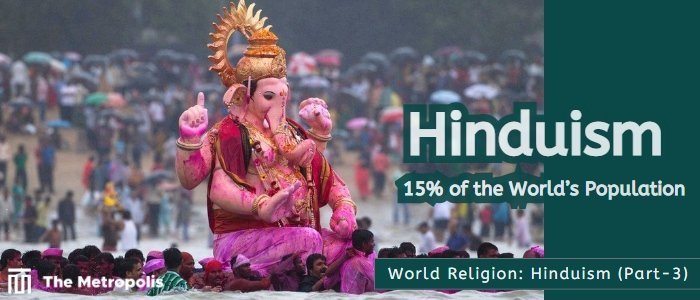Anjum Anam –
Indian Sanatan Dharma or Hinduism is a very diverse religion. Originating and adhered to Indian Subcontinent, here different peoples have different folkloric mythological stories from region to region. This religion is a combination of multiple religious beliefs of the Indian subcontinent.
Festivals
a) Diwali/ Deepavali (Lakshmi Puja)/ Shyama Puja (Kali Puja)/ Dhanteras:
Hindus all around the world celebrate Diwali, also known as Deepavali. Depending on the Hindu lunar calendar, it is a 5-day celebration that usually takes place in October or November.
Dhanteras, often referred to as Dhanatrayodashi, is the 1st day of the Diwali festival. In the Hindu month of Kartik, it is observed on the 13th lunar day of the Krishna Paksha (dark fortnight). On this day, purchasing gold or silver is thought to bring luck and wealth. They perform puja and light diyas (lamps) in the evening to welcome Goddess Lakshmi into their houses.
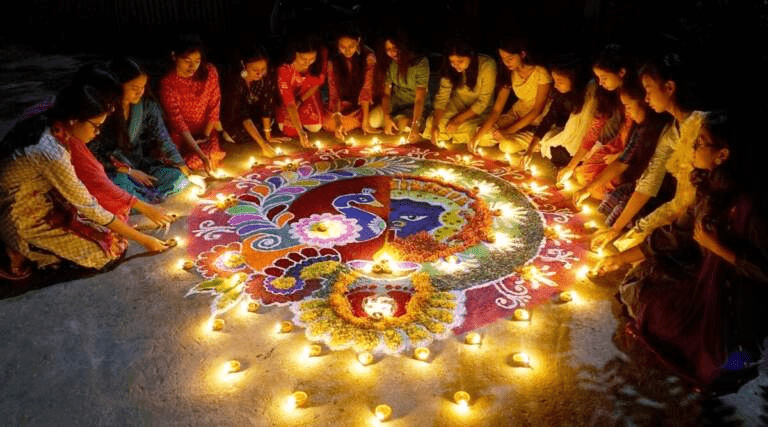
Shyama Puja is another name for the worship of Goddess Kali. In various regions of India, particularly West Bengal, Odisha, and Assam, it is an important ritual that is carried out during the Diwali holiday. It is believed that Goddess Kali’s devotion is a potent deterrent against evil and negative energy.
The Shyama Puja ceremonies are carried out on the new moon day, which follows Dhanteras. People pray to Goddess Kali while adorning their homes with flowers and lights. Chanting mantras, giving flowers and sweets, and lighting diyas are all part of the puja.
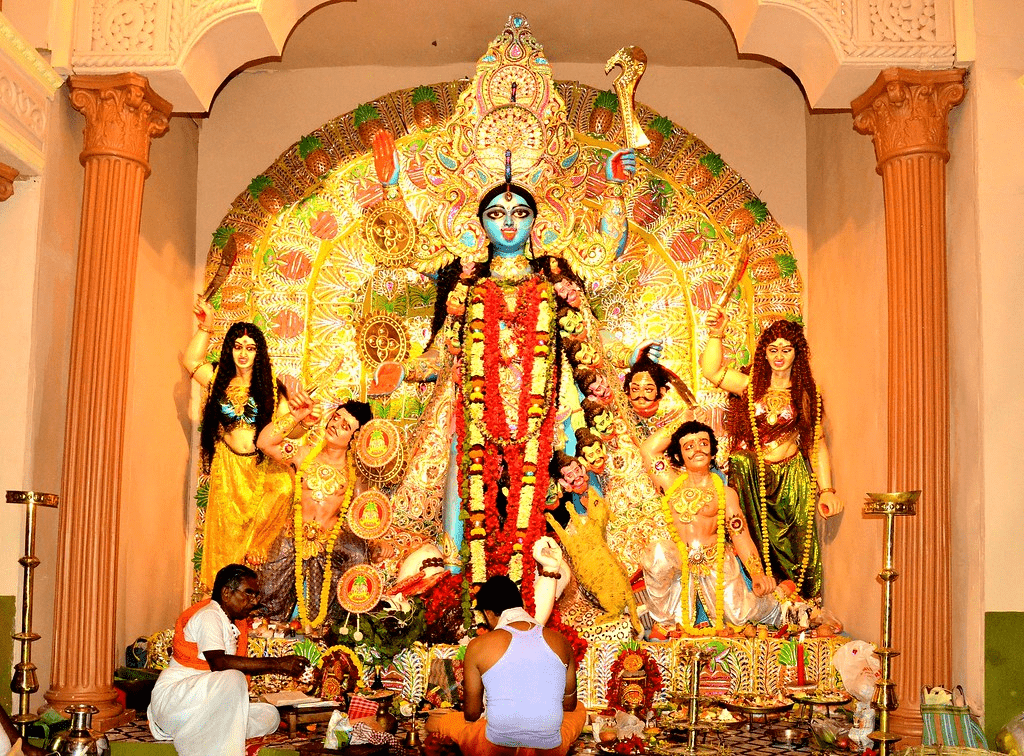
b) Durga Puja/ Navratri:
Durga Puja is a 10-day festival dedicated to the worship of the goddess Durga. It usually falls in the month of October and is celebrated with great enthusiasm in West Bengal, Assam, and other eastern states of India. As it celebrates the victory of goddess Durga over the demon Mahishasura, the festival symbolizes the triumph of good over evil.
The first day is referred to as Mahalaya; on this day, the Goddess’s eyes are painted on the idol, causing her good mercy to fall on her followers. The first 9 days are dedicated to worshiping the goddess Parvati as Durga in her 9 various manifestations, which indicates that Parvati has assumed 9 different Durga forms. The 10th day, known as Vijaya Dashami, commemorates the day the Goddess vanquishes the demons and saves mankind. For this event, no one consumes meat before the Goddess’s idol is submerged in Mahalayan water.
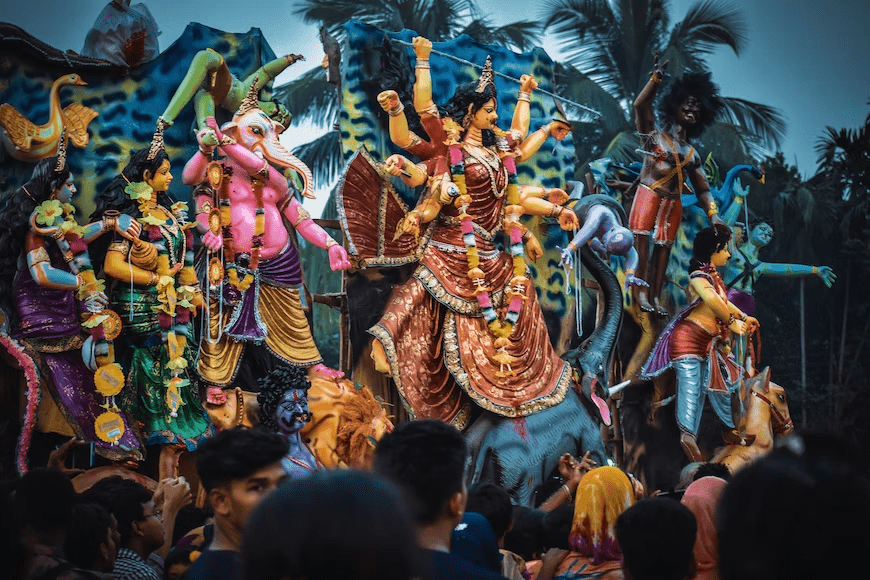
People in Western India observe this as Navratri. However, they worship Parvati in her 9 different forms over the course of 9 days rather than Durga. People keep fasts, carry out puja rites, and take part in cultural events and celebrations during Navratri. The final day of Navratri, also known as Vijayadashami or Dussehra, is also commemorated as the day that Lord Rama vanquished the demon king Ravana.
c) Dussehra:
Hindus celebrate Dussehra, also known as Dasara or Vijayadashami, as the victory of Rama, a Vishnu avatar, over the ten-headed demon king Ravana, who kidnapped Rama’s wife, Sita. Dussehra is observed on the 10th day of Ashvina (September–October), the 7th month of the Hindu calendar, at the time of the full moon, often known as the bright fortnight (shukla paksha). The 9-day Navratri festival comes to an end on Dussehra, which also falls on the 10th day of the Durga Puja holiday.
Many regions of India observe Dussehra in different ways. People perform Ram Lila, a collection of plays that chronicle Lord Rama’s life, throughout the world. To represent the annihilation of evil, the effigies of Ravana, his brother Kumbhkarna, and his son Meghnad are burned after the plays. Some cultures honor the day by worshipping the instruments and tools of their professions, such as books, pencils, and machinery.
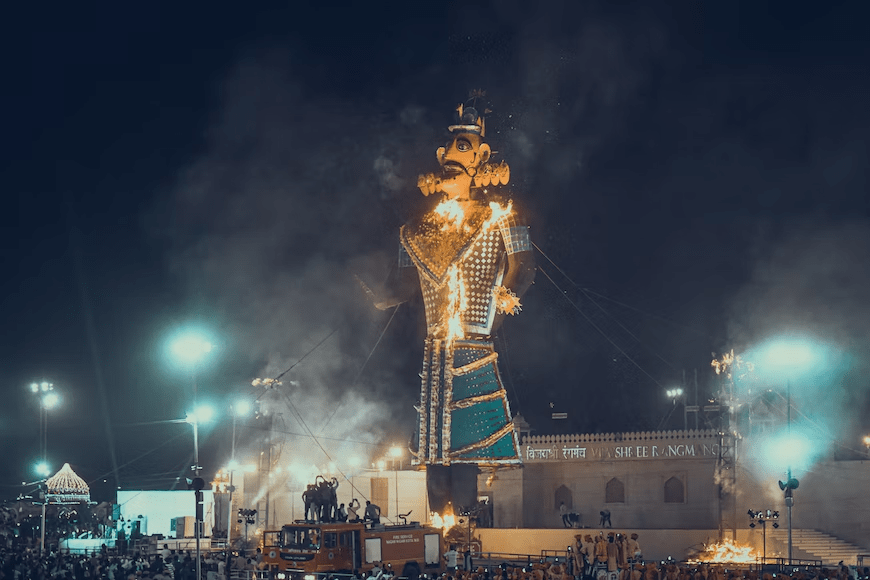
d) Rama Navami
Rama Navami commemorates the birth of Lord Rama, one of Hinduism’s most adored deities. It occurs on the 9th day of Chaitra, the month of the Hindu lunar calendar, which corresponds to March or April in the Gregorian calendar.
On this day, followers of Lord Rama maintain fasts, make prayers, and worship the Lord at home and in temples. They perform religious songs and dances and recite the epic Ramayana, the tale of Lord Rama’s life.
In various regions of India, processions are carried through the streets carrying statues of Lord Rama, Sita, Lakshman, and Hanuman. People also decorate their homes and streets with flowers and rangolis (colorful designs made with powdered rice or flour) during this time.
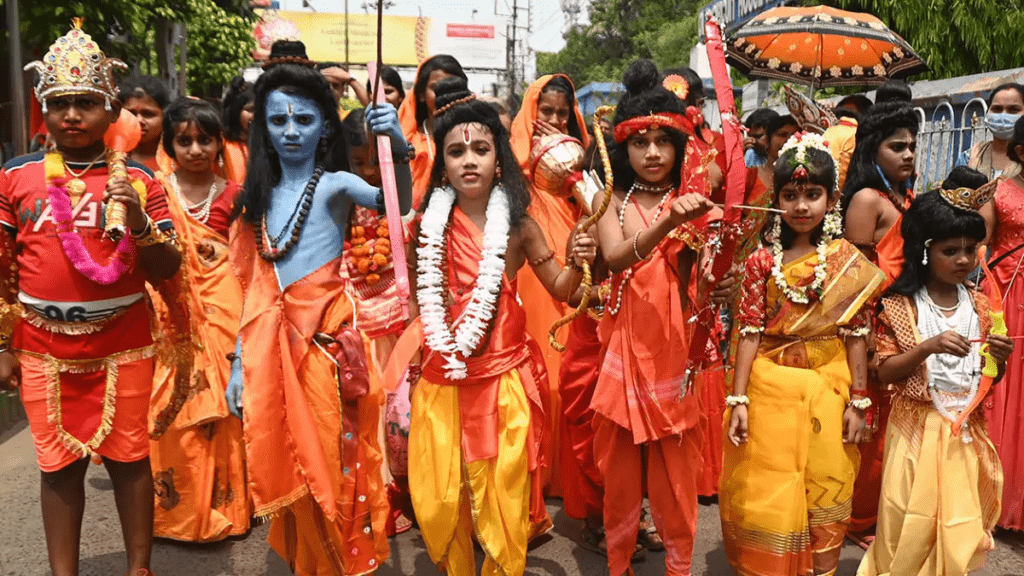
e) Raksha Bandhan/ Bhai Duj:
Raksha Bandhan is a Hindu festival that celebrates the bond between brothers and sisters. It is typically observed on the full moon day in the Hindu month of Shravana, which usually falls in August. On this day, sisters pray for their brother’s health and tie a special thread known as a “rakhi” around his wrist. Meanwhile, brothers make a lifelong commitment to look out for and support their sisters.
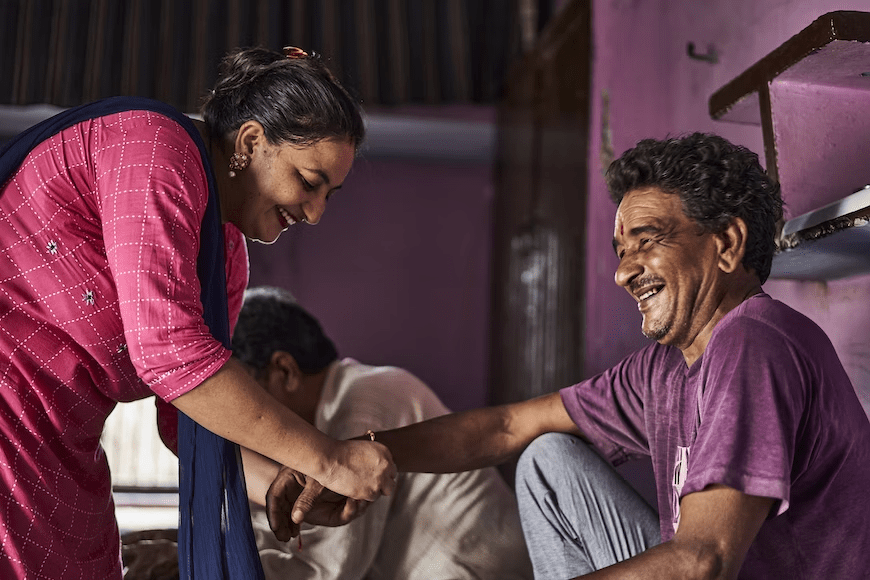
Another Hindu holiday that honors the relationship between brothers and sisters is Bhai Duj, sometimes referred to as Bhai Phota or Bhai Tika. It is observed on the 5th day after Diwali, which falls in October or November. Sisters conduct a customary ceremony for their brothers on this day, wishing them health, wealth, and happiness. In return, brothers offer gifts to their sisters and make promises to look out for and help them.
f) Tihar:
Tihar is a 5-day-long Hindu festival celebrated in Nepal and some parts of India. It usually falls between October and November, depending on the Hindu lunar calendar.
Crows are honored on the 1st day of Tihar, known as Kaag Tihar, in observance of their significance in Hindu mythology as messengers of good news. The 2nd day is Kukur Tihar when dogs are revered for their devotion to people and their friendliness. The 3rd day is Gai Tihar during which cows are worshiped as symbols of riches and prosperity. The 4th day is dedicated to Lord Krishna’s victory over the demonic monarch Indra, while the 5th day is Bhai Tika when sisters brand their brothers’ foreheads with tikas as a sign of their affection and blessings.

g) Dol Jatra/ Holi:
Dol Jatra, often known as Holi, is a well-known Hindu festival that is observed throughout Hindu populations. The festival is observed on the full moon day of the Hindu month of Phalguna, which typically falls in the month of March.
The celebration of Dol Jatra or Holi begins with the lighting of a bonfire on the night before the main day of the festival. This bonfire symbolizes the burning of the demon Holika, who tried to kill Prahlada, a devotee of Lord Vishnu. According to Hindu mythology, Prahlada was saved by Lord Vishnu, while Holika was burnt in the fire.
Holi is marked by the celebration of colors. They play with paint and water, smear colored powder on one another’s faces, and hurl water balloons at one another. The celebration is held to commemorate spring’s arrival and the triumph of virtue over evil.
The festival of Dol Jatra or Holi is also celebrated in Nepal, where it is known as Fagu Purnima.
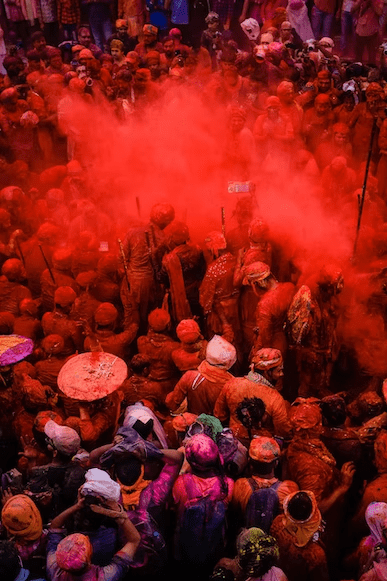
h) Nag Panchami/ Mansa Puja:
Nag Panchami is a traditional Hindu festival that is celebrated on the 5th day of the bright half of the lunar month of Shravana. This day is devoted to the veneration of snakes, who are revered in Hindu mythology as holy beings. On Nag Panchami, people worship snakes and give them milk in exchange for their protection from their poisonous bites.
Nag Panchami is closely connected to Mansa Puja, sometimes referred to as Mansa Devi devotion. Mansa Devi is revered as the snake goddess because of her ability to shield humans from perils like snake bites.
Devotees pray and carry out rituals during Mansa Puja to enlist the goddess Mansa Devi’s blessings. This festival is especially popular in North India, particularly in the states of Uttar Pradesh, Bihar, and Jharkhand.
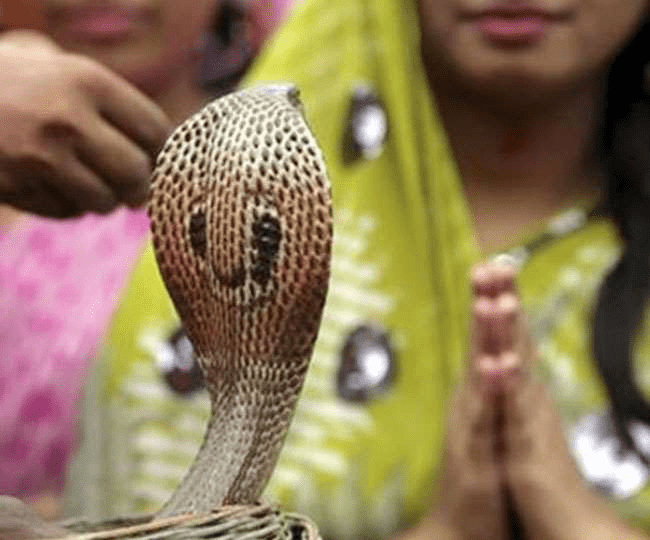
i) Mahashiv Ratri:
Maha Shivaratri is a Hindu festival celebrated annually in honor of Lord Shiva, one of the principal deities of Hinduism. The name Maha Shivaratri means “Great Night of Shiva”, and the festival is observed on the 14th day of the dark fortnight in the Hindu month of Phalguna or Maagha (February or March).
Devotees of Lord Shiva maintain fasts, remain up all night, and make prayers and offerings to the god throughout the festival. Also, plenty of people go to Shiva temples and take part in numerous rites and festivities. In Hindu mythology, the event is of immense significance and is regarded as a highly lucky day to worship Lord Shiva.
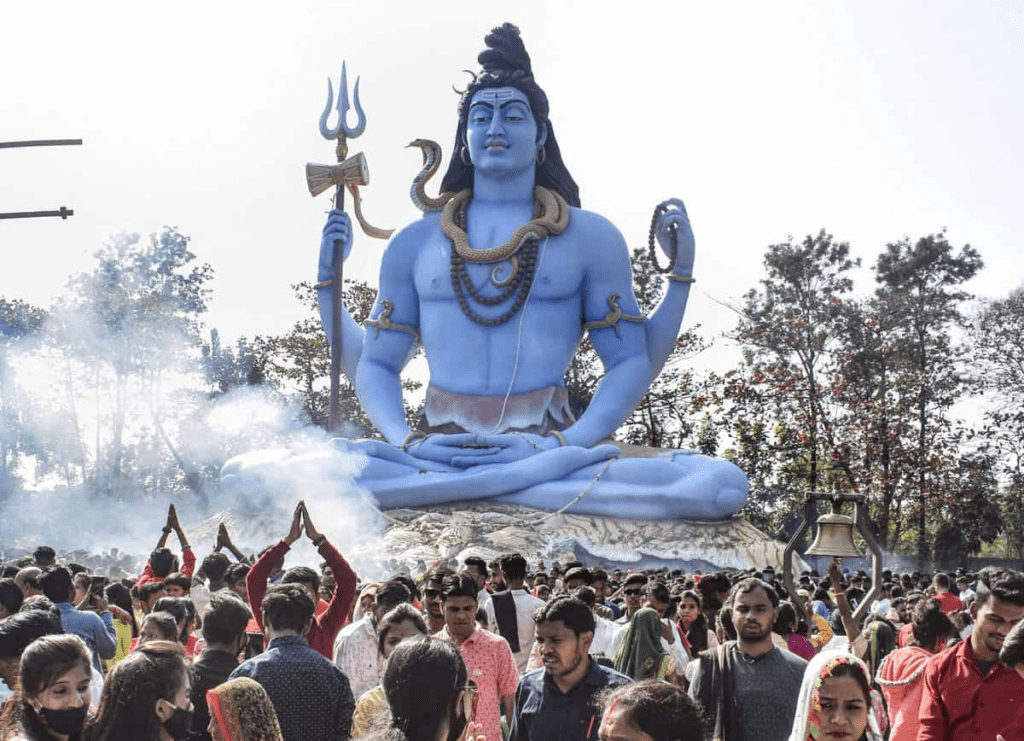
j) Ganesh Chaturthi:
Ganesh Chaturthi is a Hindu festival that celebrates the birth of Lord Ganesh, the elephant-headed god. The festival usually falls in the Hindu month of Bhadra, which is usually in August or September according to the Gregorian calendar.
People adorn their houses and public areas with bright decorations, flowers, and lights during Ganesh Chaturthi. They also make idols of Lord Ganesh and pray to him and give him treats. The idols are then submerged in water, typically in a river or the sea, signifying Lord Ganesh’s return to his celestial residence.
The festival is celebrated with great enthusiasm in many parts of India, especially in Maharashtra, where it is a major cultural event.
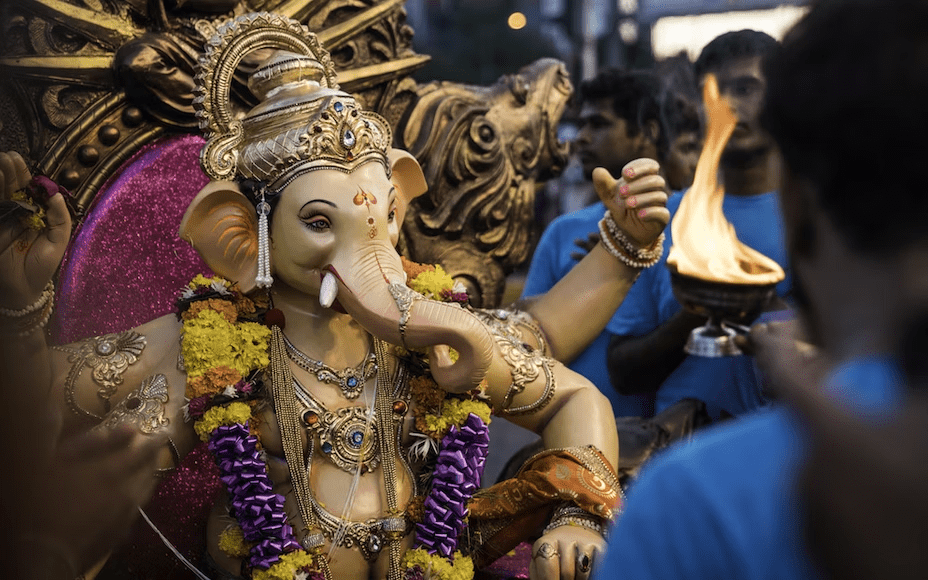
k) Janmashtami:
Janmashtami is a Hindu festival celebrated every year to mark the birth of Lord Krishna, who is considered one of the most important gods in Hinduism. The festival is observed on the 8th day (Ashtami) of the Krishna Paksha (dark fortnight) of the Hindu month of Bhadra (August/September in the Gregorian calendar).
Hindus around the world commemorate Janmashtami with a lot of fervor and dedication. On this day, devotees maintain fasts, perform devotional songs, and pray to Lord Krishna. They also prepare special food offerings for the deity and decorate their houses and temples with flowers and lights.
The Dahi Handi event, which honors Lord Krishna’s boyhood antics of stealing butter and curd by having participants create a human pyramid to reach and smash a pot of curd, is one of the festival’s primary attractions.
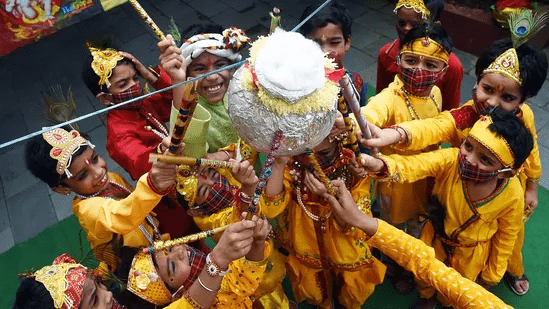
l) Thaipusam:
Thaipusam is a Hindu festival that is celebrated primarily by Tamil communities in India, as well as in other parts of the world where there is a significant Tamil population, such as Malaysia, Singapore, and Sri Lanka. The festival is usually held in the Tamil month of Thai (January/February) and is a celebration of the victory of Lord Murugan (also known as Subramanya or Skanda) over the demon Soorapadman.
Thaipusam is known for its elaborate processions and rituals. Devotees frequently carry intricate kavadis, which are ornamental frames made of wood or metal that are attached to the body of the devotee by hooks and skewers and ornamented with flowers and peacock feathers. Before the celebration, the kavadi carriers frequently go through fasting and purification periods. They may even perform extreme acts of penance and self-mortification while in the parade.
Thaipusam is also characterized by the hymn and mantra chanting, traditional dance and music performances, and the presentation of fruits and sweets to Lord Murugan.
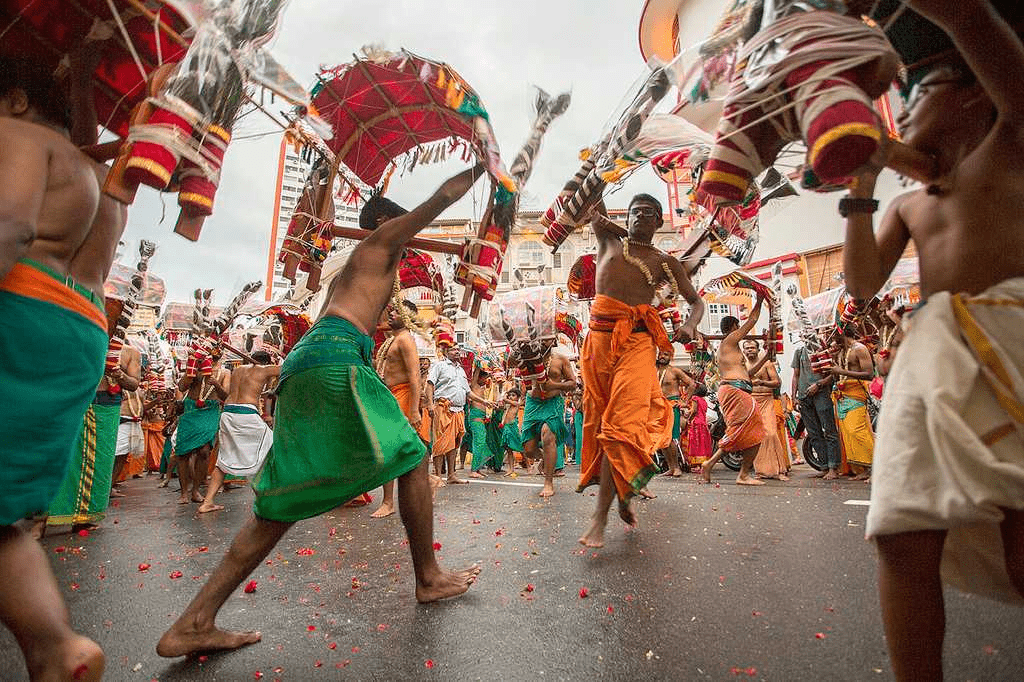
m) Rath Jatra:
Rath Jatra, also known as the Festival of Chariots, is an annual Hindu festival celebrated primarily in the city of Puri in the Indian state of Odisha. The festival is dedicated to Lord Jagannath, an incarnation of Lord Vishnu, and is one of the most important festivals in the Hindu calendar.
The event lasts 9 days and is held in the months of June or July on the 2nd day of the waxing phase of the moon. 3 enormous wooden chariots are constructed at this time, one for each of Lord Jagannath, his brother Balabhadra, and his sister Subhadra. The chariots are drawn by devotees through the streets of Puri and are decked with bright fabrics, flowers, and paintings.
The chariots are pulled in a parade from the Jagannath Temple to the Gundicha Temple, which is roughly 2 kilometers away. Thousands of followers come to Puri to take part in the event and pull the chariots from all across India and the world. The dragging of the chariots is seen as a very auspicious act, and people who take part are said to receive Lord Jagannath’s blessing.
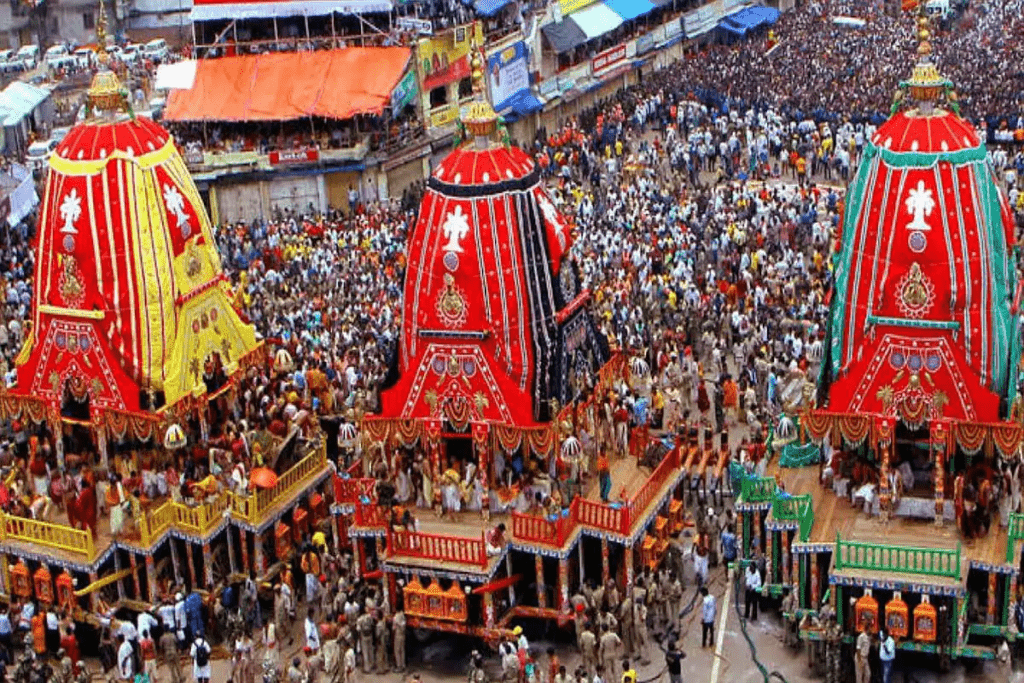
n) Chhath Pooja:
Chhath Puja is a Hindu festival that is mainly celebrated in the Indian states of Bihar, Jharkhand, and Uttar Pradesh, as well as in some parts of Nepal. The event is devoted to the worship of Surya, the Sun God, and Usha, his wife. It is thought that one can receive Surya and Usha’s blessings for well-being, prosperity, and happiness by praying and engaging in rituals during Chhath Puja.
Chhath Puja is observed on the 6th day of Kartik month, which often falls in October or November. During the 4-day celebration, worshippers fast, pray to the Sun God, and engage in a number of rituals, including taking a dip in a sacred river, standing in water for extended periods of time, and offering arghya (water offerings) to the setting and rising sun.
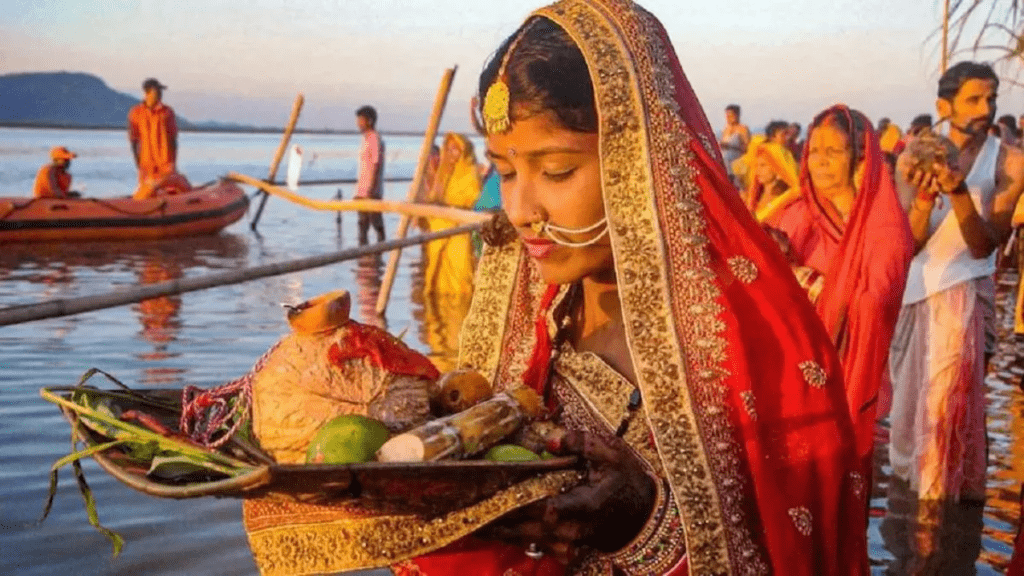
o) Teej/ Karva Chauth:
Teej and Karva Chauth are two traditional festivals celebrated primarily by women in India.
Teej is mainly celebrated in the northern and western parts of India. This festival honors Goddess Parvati, who is revered as the personification of devotion and love. On this day, married ladies fast for the health of their husbands, and single girls fast for a good husband. On the 3rd day of the Hindu lunar month of Shravan, which normally falls in July or August, the festival is observed.
Married Hindu ladies in India also celebrate Karva Chauth. It is celebrated on the 4th day of Kartik, a lunar month in Hinduism that often occurs in October or November. For the safety and long life of their husbands, married ladies conduct a day-long fast from dawn to moonrise on this day. Also, ladies dress up in traditional garb on this day, henna their hands, and engage in puja rites.

p) Chheti Chand:
Chheti Chand is a festival celebrated by the Sindhi community to mark the beginning of the Hindu calendar in the month of Chaitra (March-April). It is also known as Jhulelal Jayanti.
The Indian states of Gujarat and Maharashtra, as well as the Pakistani province of Sindh, celebrate the festival with a great deal of intensity and enthusiasm. On this day, Sindhi people worship Lord Jhulelal, who is seen as a manifestation of the God of Water, Lord Varuna.
The festival is observed by a number of ceremonies and traditions, including the hoisting of a flag bearing a picture of Jhulelal, reciting prayers, and giving out prasad. Participants in processions and cultural events dress in traditional clothing.
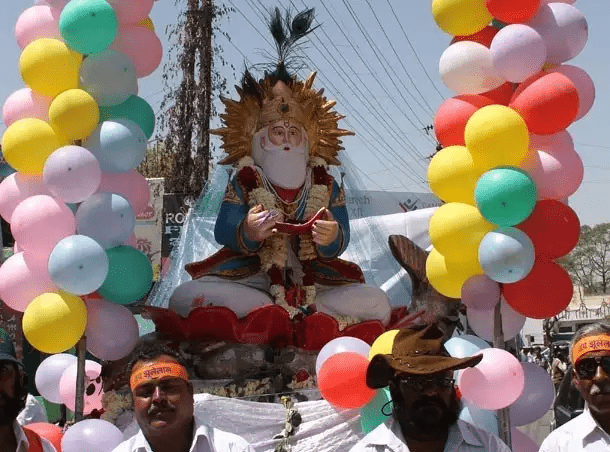
Other Festivals
a) Hindu New Year:
Hindu New Year is celebrated under different names in different parts. The festival is known as Ugadi in Andhra Pradesh and Telangana, Yugadi in Karnataka, Gudi Pawa in Maharashtra, Puthandu in Tamil Nadu, Vishu in Kerala, Sajibu Nongma Panba Cheiraoba in Manipur, Pana Sankranti in Odisha, Rongali Bihu in Assam.
b) Bhogi/ Lohri/ Onam/ Makar Sankranti/ Maghi/ Naukhai/ Uttarayan:
Bhogi is a harvest festival celebrated in the southern state of Tamil Nadu. It is usually celebrated on the day before the famous festival of Pongal and is dedicated to Lord Indra, the god of rain.
Lohri is a winter festival celebrated mainly in the north Indian states of Punjab, Haryana, and Delhi. It marks the end of the winter solstice and the beginning of longer days.
Onam is a 10-day harvest festival celebrated in the southern state of Kerala. It is believed to be the homecoming of the legendary king Mahabali.
Makar Sankranti is a harvest festival celebrated across India, usually on the 14th of January. It marks the transition of the sun into the zodiac sign of Capricorn (Makar). This festival is celebrated with kite flying.
Maghi is a winter festival celebrated in the northern parts of India, especially in Punjab. It usually falls on the 14th of January, and it marks the beginning of the month of Magh according to the Hindu calendar.
Naukhai is a harvest festival celebrated by the people of western Odisha. It is dedicated to the goddess Samaleswari and is celebrated on the Panchami Tithi (5th day) of the lunar fortnight of the Hindu month of Bhadra.
Uttarayan is a festival celebrated in the western state of Gujarat, mainly in the city of Ahmedabad. It is dedicated to the sun god and marks the end of winter and the beginning of spring. People fly kites on this day.
Pilgrimage
a) Kumbh Mela:
Kumbh Mela is a major pilgrimage and festival in Hinduism, celebrated in 4 different locations in India: Haridwar, Allahabad (Prayagraj), Nashik, and Ujjain. With millions of Hindu pilgrims and devotees in attendance, it is regarded as the world’s greatest peaceful assembly of people.
Every 12 years, the Kumbh Mela is conducted in 1 of the 4 places. The Ardh Kumbh Mela is a smaller version held every 6 years in addition to the major festival.
The event is centered on myths and tales from Hinduism, notably the tale of how gods and demons churned an ocean of milk to acquire “Amrita”, the elixir of immortality. Devotees participate in the event by taking a holy bath in the river or other body of water at the festival’s designated venue, which is thought to wash away their sins and move them closer to enlightenment.
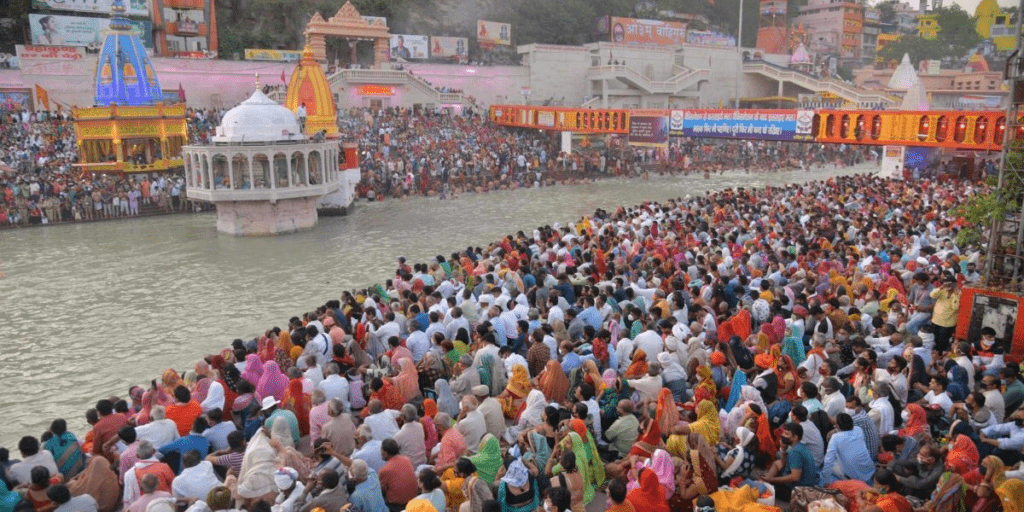
b) Char Dham:
Char Dham (meaning 4 abodes) refers to the four sacred pilgrimage sites in Hinduism – Badrinath, Dwarka, Puri, and Rameswaram. The 4 Dhams are, Badrinath, Dwarka, Puri, and Rameswaram. Every Hindu is supposed to travel to the Char Dham at least once in their lives.
Badrinath is located in the state of Uttarakhand. It is situated in the Himalayan foothills beside the Alaknanda River. It is believed to be the place where Lord Vishnu meditated and attained enlightenment. The main attraction of Badrinath is the Badrinath Temple, which is dedicated to Lord Vishnu.
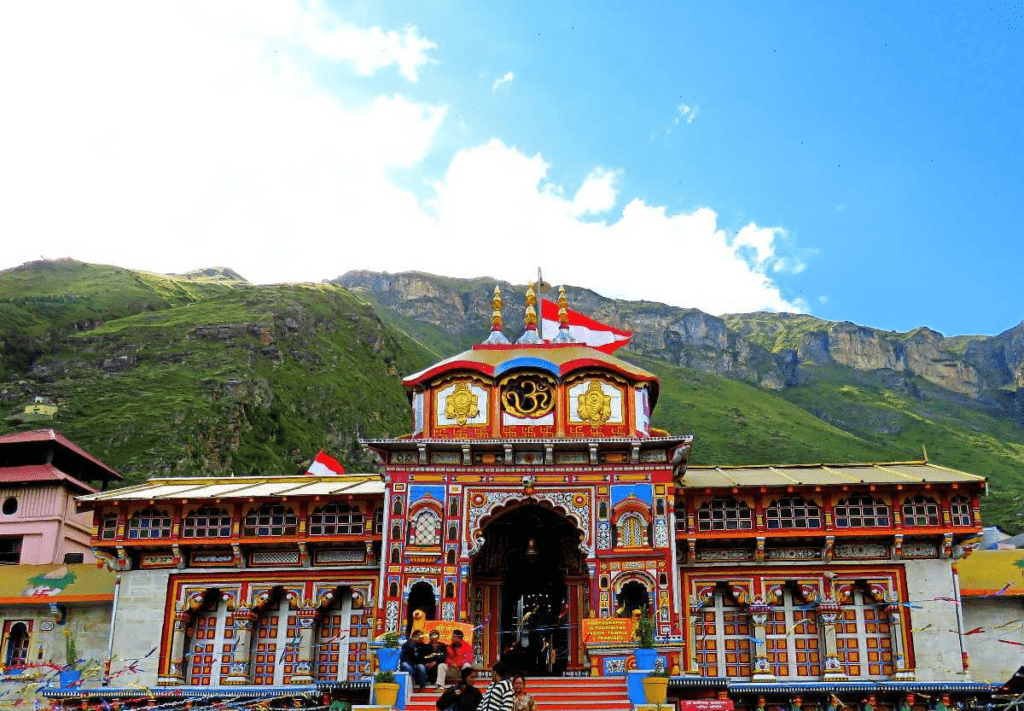
Dwarka is located in the state of Gujarat. It is one of the seven most ancient cities in India. It is believed to be the place where Lord Krishna lived and ruled as king. The main attraction of Dwarka is the Dwarkadhish Temple, which is dedicated to Lord Krishna.
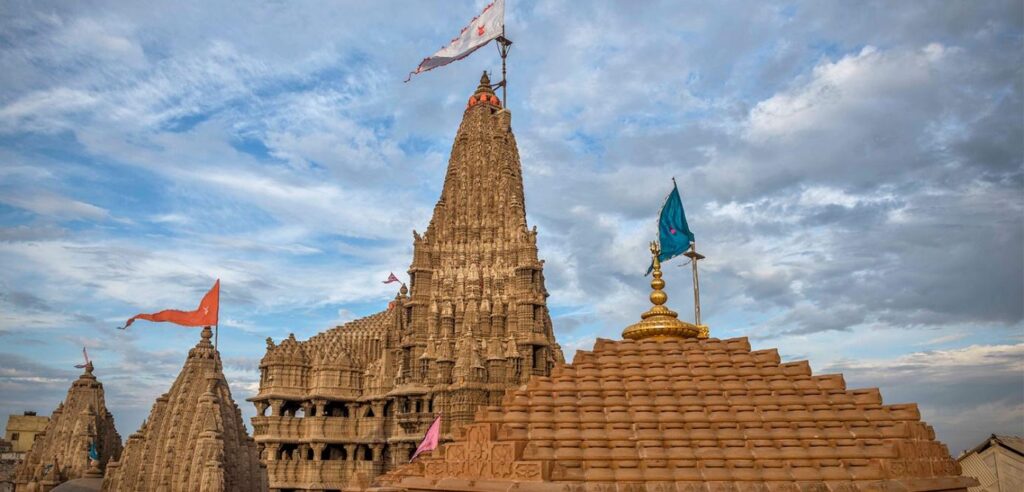
Puri is located in the state of Odisha. It is famous for the Jagannath Temple, which is dedicated to Lord Jagannath, an incarnation of Lord Vishnu. The temple is known for its annual Rath Yatra, where the deities are taken out in a grand procession.
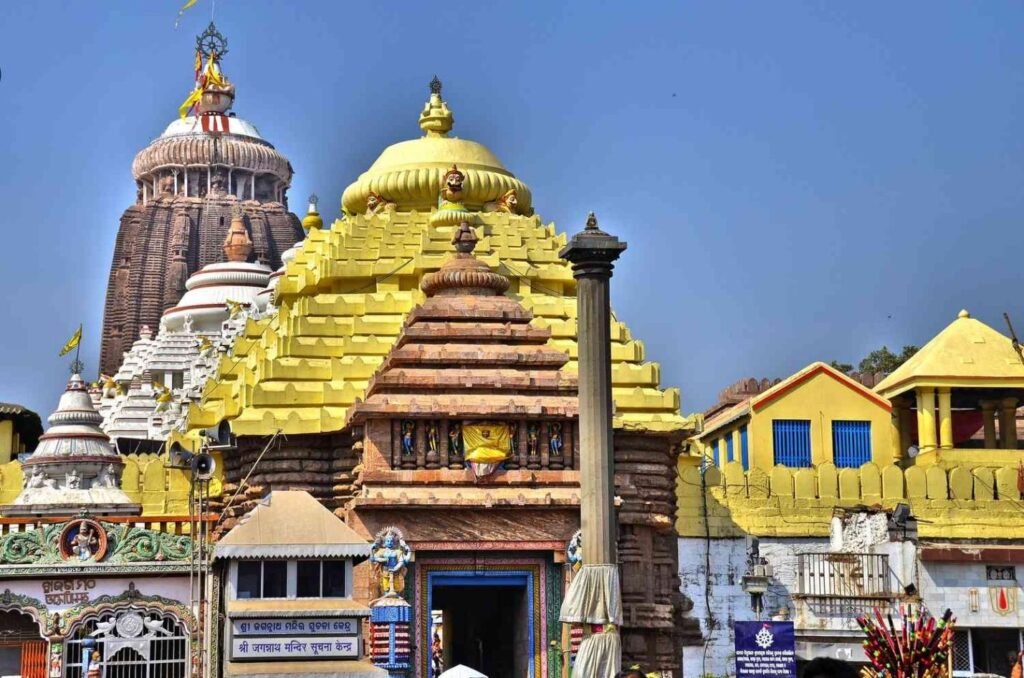
Rameshwaram is located in the state of Tamil Nadu. It is believed to be the place where Lord Rama built a bridge to Lanka to rescue his wife Sita. The main attraction of Rameshwaram is the Ramanathaswamy Temple, which is dedicated to Lord Shiva.
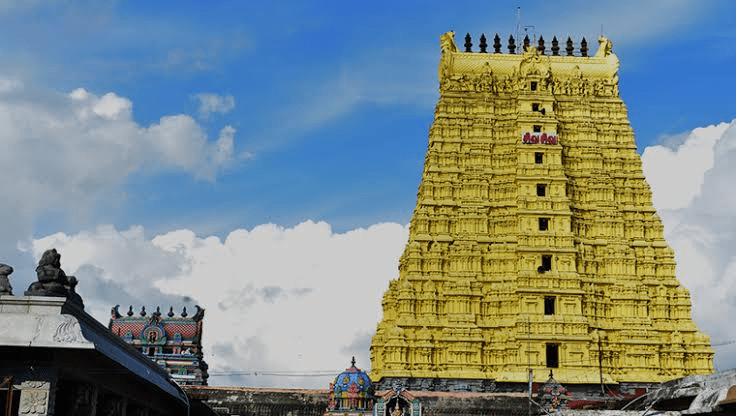
b) Chota Char Dham:
Chota Char Dham refers to a set of four Hindu pilgrimage sites located in the Indian state of Uttarakhand. The four sacred shrines are Yamunotri, Gangotri, Kedarnath, and Badrinath.
Yamunotri is dedicated to Goddess Yamuna, Gangotri to Goddess Ganga, Kedarnath to Lord Shiva, and Badrinath to Lord Vishnu. These four sites are considered highly sacred by Hindus, and visiting them is believed to wash away sins and bring salvation.
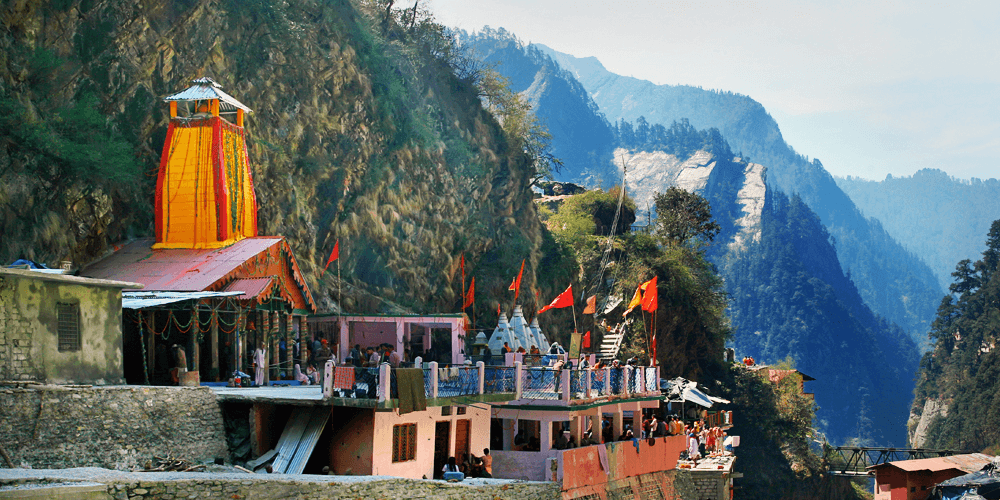
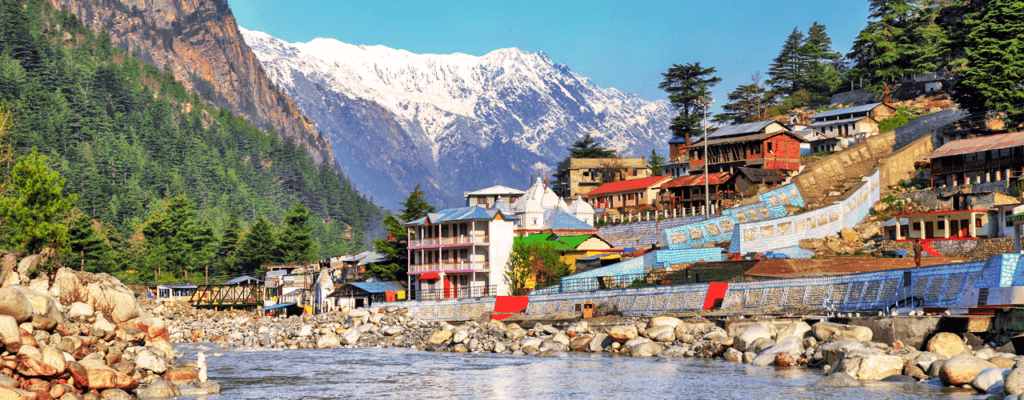
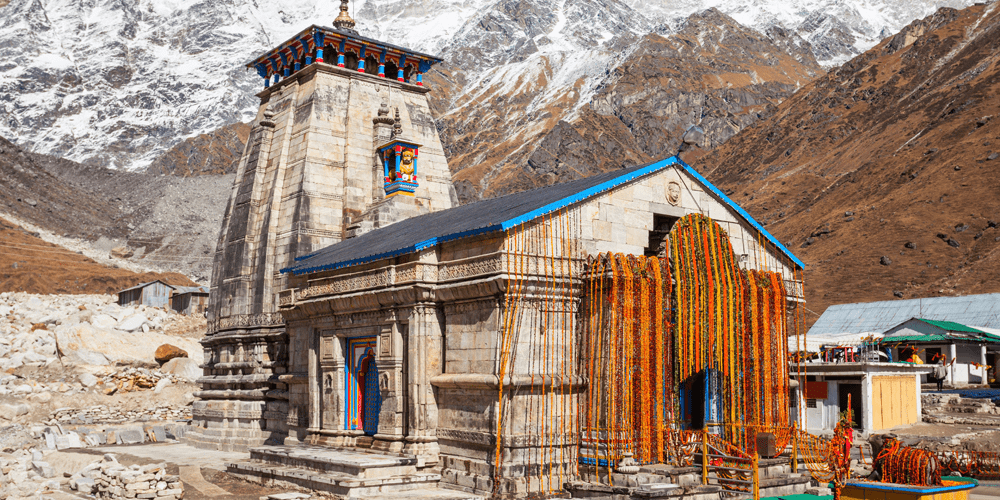

Typically, the Chota Char Dham Yatra (pilgrimage) begins in Yamunotri before moving on to Gangotri, Kedarnath, and Badrinath. Due to heavy snowfall blocking the roads leading to these sites throughout the winter, the yatra is only accessible to pilgrims from April to November.



